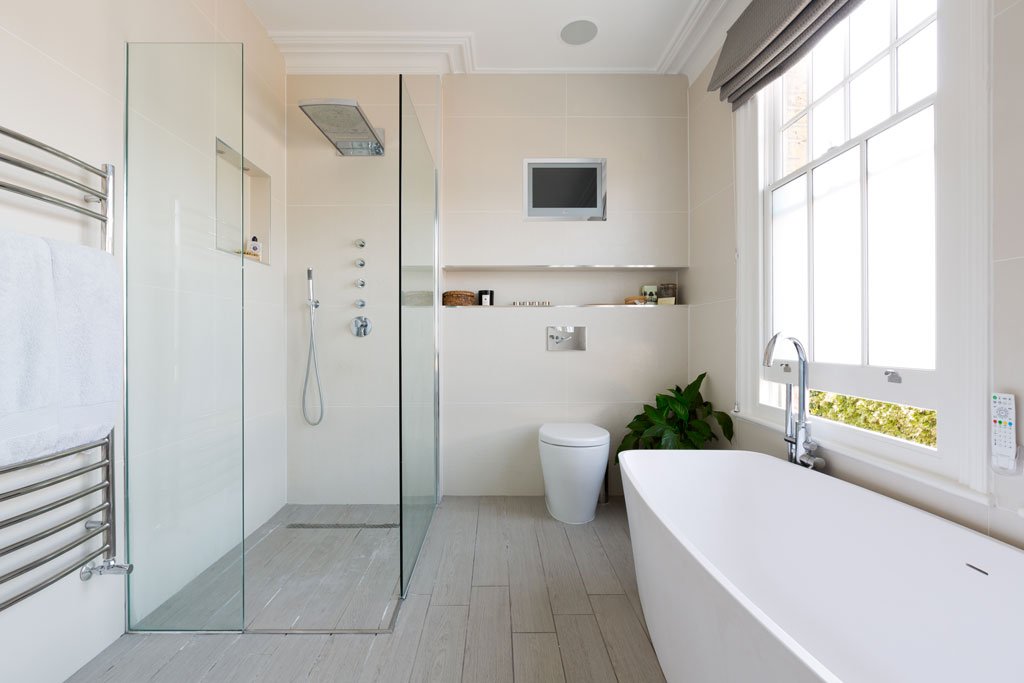Introduction
Simple everyday tasks might become more challenging as we age or have mobility issues. This is especially true for personal hygiene procedures such as showering. Traditional bathrooms can create hurdles for the elderly and those with mobility issues, which can lead to dissatisfaction, loss of independence, or even dangerous accidents. But what if there was a solution that made bathrooms safer and more convenient to use? Enter the walk-in shower, a game changer in the realm of accessible home design.
In this article, we’ll look at the many ways walk-in showers increase accessibility and safety, allowing seniors and those with mobility challenges to maintain their independence with confidence.
What Are Walk-in Showers?
Definition of Walk-in Showers
A walk-in shower is a form of shower that eliminates barriers such as high borders or steps, allowing users to walk (or wheel) directly into the shower room without having to climb or maneuver over a ledge. These showers are constructed with accessibility in mind, with open entry points and larger rooms for easy mobility.
How Walk-in Showers Differ from Traditional Showers
Traditional showers typically involve stepping over a lip or into a bathtub, which can be dangerous for people with restricted mobility. Walk-in showers, on the other hand, are intended to be more user-friendly, frequently removing these barriers entirely, and providing a simple and safer alternative.
The Importance of Accessibility in Bathrooms
Common Challenges Faced by Seniors in Traditional Bathrooms
Traditional bathrooms might be hazardous for people with mobility issues. Slippery surfaces, high tub edges, and the need to balance while stepping over barriers can all cause serious falls. This is especially concerning for the elderly, who are more susceptible to fall-related injuries. Even simple actions, such as standing for extended periods of time, can be exhausting or uncomfortable.
Impact of Mobility Issues on Daily Hygiene Routines
Even a simple hygiene routine can be overwhelming for persons with mobility limitations. Needing assistance to bathe can have an impact on one’s sense of independence and dignity, which is why accessible bathroom designs such as walk-in showers are so vital.
Key Features of Walk-in Showers for Accessibility
Barrier-free Entry
One of the most important characteristics of walk-in showers is their barrier-free design. They are accessible to people who use walkers, canes, or wheelchairs because there is no lip or step to trip over.
Adjustable Shower Heads
Walk-in showers frequently feature adjustable shower heads that can be lowered or lifted, making them ideal for anyone who needs to sit while showering. This extra flexibility makes the shower suitable for those with varying levels of mobility.
Built-in Seating Options
Many walk-in showers have built-in chairs, which can be extremely useful for folks who are unable to stand for extended periods of time. This enables people to bathe pleasantly and safely, without risk of weariness.
Slip-resistant Flooring
Slip-resistant flooring is another important characteristic of walk-in showers. These flooring are designed to lessen the likelihood of a fall, providing further peace of mind for anyone concerned about slipping in the restroom.
Safety Benefits of Walk-in Showers
Reduction of Slip-and-Fall Risks
Walk-in showers, with their low thresholds and slip-resistant surfaces, minimize the risk of falls significantly when compared to typical tub-and-shower combos. These features make them ideal for elderly who are more likely to have restroom accidents.
Safer Alternatives to Bathtubs
Bathtubs frequently require stepping over a high edge, which can be hazardous for people with poor balance. Walk-in showers eliminate this threat by allowing users to enter the shower with no barriers in their path.
Grab Bars and Support Handles for Additional Security
Walk-in showers can be outfitted with grab bars and support handles, which are essential for people who require additional stability while standing or moving. These elements can help to prevent accidents and provide additional security for persons who may feel shaky.
How Walk-in Showers Enhance Independence
Allowing Seniors to Shower Without Assistance
One of the most significant advantages of a walk-in shower is that it enables the elderly and persons with mobility challenges to shower without help, giving them a new sense of independence. This is extremely powerful since it allows people to manage their personal hygiene without relying on others.
Improving Self-confidence with Simple Hygiene Tasks
Knowing that they can care for themselves, even in modest ways such as showering, can significantly boost seniors’ self-esteem and confidence. Walk-in showers allow this freedom, making day-to-day life easier.
Customizable Features for Personal Needs
Tailoring to Specific Mobility Concerns
Every person’s mobility requirements are unique, which is why walk-in showers can be outfitted with amenities such as handheld showerheads, foldable seats, and even wheelchair accessibility. This adaptability means that the shower can fulfill the user’s individual requirements.
Luxury Options for Both Comfort and Functionality
Some walk-in showers include luxury features such as rain showerheads and steam functions. These can make the everyday routine more fun while yet ensuring crucial accessibility.
Comparison Between Walk-in Showers and Traditional Bathtubs
Difficulties of Stepping into a Bathtub vs. Ease of Walk-in Showers
Traditional bathtubs necessitate a certain degree of balance and flexibility, which can be difficult for those with mobility impairments. Walk-in showers remove this barrier, making it much easier to get in and out of the shower safely.
How Walk-in Showers Save Space and Offer Practicality
Walk-in showers are often more space-efficient than traditional bathtubs, making them a practical solution for smaller bathrooms. This can also contribute to a more streamlined and modern look.
Also Read: Why Upgrade Your Bathtub Stopper This Year
The Psychological Impact of Walk-in Showers
How Improved Accessibility Reduces Stress
Struggling to do daily routines such as showering can lead to tension and worry. Walk-in showers address this by creating a safer, more user-friendly environment, minimizing the mental strain associated with typical bathroom layouts.
The Importance of Dignity and Independence in Personal Care
Maintaining independence in personal care routines is critical for preserving dignity, especially among the elderly. Walk-in showers allow people to take responsibility for their hygiene, which is beneficial to their general well-being.
Walk-in Showers as Part of Aging in Place
Importance of Aging in Place
Aging in place is the capacity to live independently and safely in one’s own house as one becomes older. Walk-in showers play an important role in this because they make the home environment safer and more accessible, allowing seniors to remain in their homes for longer.
How Accessible Bathrooms Contribute to Long-term Home Living
Making changes, such as constructing a walk-in shower, is an investment for the future. Accessible bathrooms are essential components of houses designed for aging in place because they meet the demands of seniors at varying stages of mobility.
Costs and Installation Considerations
Initial Costs of Walk-in Showers
While walk-in showers may have greater initial expenditures than regular bathtubs, they provide long-term benefits in terms of safety, comfort, and accessibility. Prices vary depending on bespoke features and the size of the shower space.
Professional Installation vs. DIY
Hiring a professional is typically the best way to ensure correct installation. There are DIY choices for certain simple walk-in shower models, but they may not incorporate all of the necessary accessible features.
Maintenance and Durability of Walk-in Showers
Easy-to-clean Surfaces
Walk-in showers frequently use easy-to-clean materials, making them a low-maintenance solution for homeowners. This is especially crucial for elders, who may struggle with hefty cleaning tasks.
Longevity of Accessible Bathroom Solutions
Walk-in showers, when correctly installed, are built to last, providing long-term, durable, and safe solutions. This makes them an excellent choice for anyone wishing to increase bathroom accessibility.
Additional Features for Safety and Comfort
Anti-scald Valves
Anti-scald valves are an important safety element that regulates water temperature and reduces the risk of burning. This is especially crucial for the elderly, who may have more sensitive skin.
Shower Benches and Foldable Seats
Walk-in showers might have benches or foldable seats to improve comfort and accessibility. These provide a safe, pleasant place to sit while showering, improving the shower’s accessibility characteristics.
Conclusion
Walk-in showers are an excellent way to improve accessibility in the house, especially for the elderly and people with mobility challenges. These showers make everyday hygiene practices safer, more pleasant, and more empowering by including features such as barrier-free entrance, slip-resistant flooring, and customized options. The psychological benefits of greater independence and less stress cannot be stressed.
Investing in a walk-in shower is more than simply a home renovation; it is a step toward maintaining dignity and freedom for many years to come.




